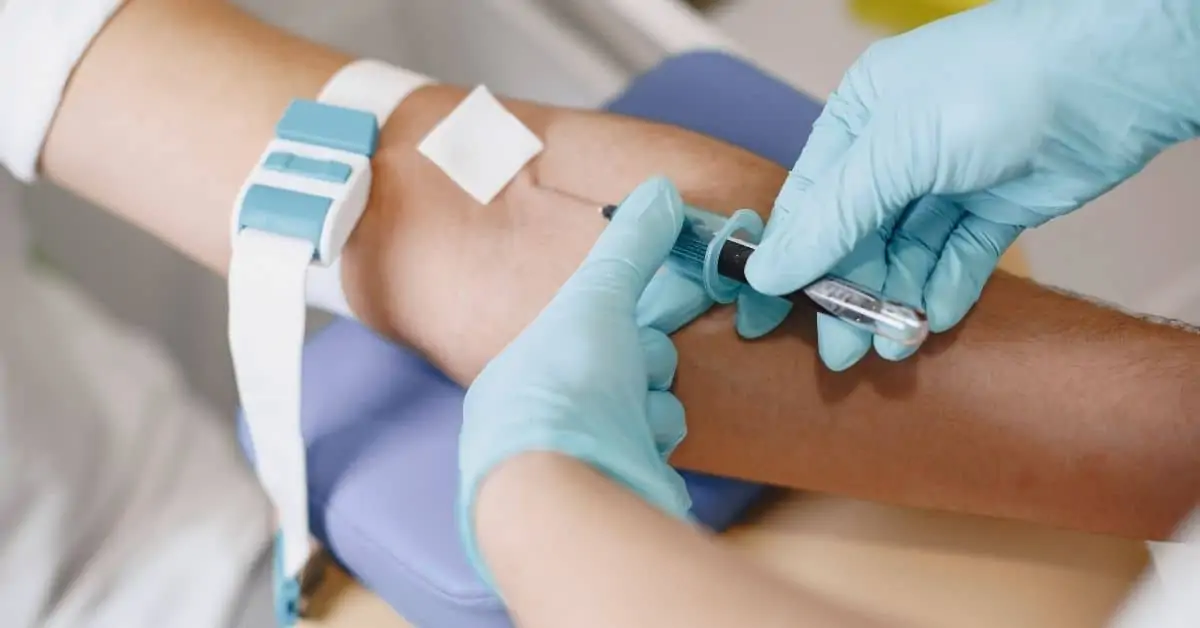Given the importance of information that blood samples can glean regarding a patient’s health, phlebotomy is a highly in-demand field. What is a phlebotomist? Learn about the field, how to become certified, average salary, and job outlook.
From time to time, you’ve probably had your blood drawn. After all, it’s a common and normal procedure that most people go through at least occasionally. You may think that a nurse drew your blood, but a phlebotomist was probably the professional who did it.
You know the trivia question that goes a little something like: “what is a nurse that draws blood called?” Well, if you’ve ever received that one, then you probably know that the answer is tough to say and even tougher to spell!
What is phlebotomy?
This funny-sounding word simply refers to the process of taking blood samples for diagnostics (i.e., lab work) or therapy (donating blood) purposes.
And it’s a medical field that’s both essential and rewarding. Simple blood tests can reveal a lot about a person’s health. That’s why when people experience medical issues, one of the first things a doctor will order is a blood draw.
What does a phlebotomist do?
A phlebotomist is a medical professional who has been specifically trained to draw blood samples in different ways for medical testing, donation, or transfusions. They may collect blood through venipuncture, or finger or heel pricks.
In addition to actually drawing blood samples, phlebotomists also manage blood samples to ensure proper tracking and testing and conduct transfusions.
Other typical duties include:
- Explaining the blood draw or transfusion process and preparing patients by answering any questions.
- Preparing stains and reagents
- Ensuring that all samples are properly labeled with the correct patient’s information.
- Managing and tracking blood samples to ensure they’re good samples.
- Gathering and inventorying necessary blood draw supplies and instruments.
- Cleaning and sterilizing equipment
- Updating patient records
- Caring for and helping nervous patients through the process of blood draws or transfusions.
- Providing assistance to patients experiencing adverse reactions after a blood draw or transfusion.
Where do phlebotomists work?
As a person who draws blood samples from patients, you could see a phlebotomist working in a variety of places:
- Hospitals
- Medical clinics
- Outpatient facilities
- Laboratories
- Research Institutes
- Home health agencies
- Public health facilities
- Centers where people donate blood
What is a mobile phlebotomist?
This is simply a phlebotomist who travels to various locations for events like blood drives in order to do their job.
Are nurses and phlebotomists the same?
Phlebotomists can be nurses. However, in settings other than hospitals, they’re more often other medical professionals who have their own targeted training and work alongside nurses and doctors.
There is some debate around whether nurses could just draw blood samples since they do other similar things such as starting IVs. While there can be some overlap, there are a couple of major reasons for this important distinction between professions.
For one, nurses are busy performing a huge number of other tasks concerning patient care and must often stick with schedules as prescribed by a doctor. Sometimes blood draws don’t follow a certain schedule which can throw off a nurse’s rhythm of patient care.
In addition, different blood tests require different collection procedures. Unlike nurses, phlebotomists are specifically trained in each of those procedures. For this reason, they are more likely to retain the integrity of the sample which will yield more accurate test results.
How To Become A Phlebotomist
In order to be a successful phlebotomy technician there are a few traits that someone much possess:
- Detail-oriented
- Work well under pressure
- Effective communicator
- Like taking on a challenge and responsibility
If this sounds like a good fit for you, then it’s time to investigate how to get certified as a Phlebotomy Technician.
Two Tracks For Getting The Necessary Training
There are two basic ways you can become a phlebotomist.
First, if you don’t have experience in any medical field, you’ll need to complete a phlebotomy program from an accredited university or technical school. This will help you gain the necessary classroom instruction and hands-on training that you’ll need to get hired and work as a nurse who takes blood.
Coursework typically includes:
- Anatomy and physiology
- Blood and cell composition – the crux of phlebotomy is understanding how blood and cells are affected by disease and infection.
- Blood sampling procedures – people of all ages have different factors that must be taken into account when drawing blood.
- Laboratory safety – learning how to safely handle samples and lab equipment in order to protect yourself and others from injury and infection.
- CPR – This is becoming more and more commonly included with phlebotomy courses.
Certification
The training usually takes less than a year and should prepare you to take the National Certified Phlebotomy Technician exam. Many employers look for candidates who have passed the NCPT certification.
The other method is for certified medical professionals in other fields to complete training and pass the exam.
NOTE: There are four states that also require phlebotomists to receive a special state certification:
- California
- Louisiana
- Nevada
- Washington
Choosing Your Coursework Program
When investigating different program options, consider these factors:
- How long it takes to complete the program: various programs can vary in length, but most are generally finished in under a year. As you think about the program length, also be sure to factor in how flexible the schedule is.
- Convenience: how close is your phlebotomy training to your home? Will commuting be too difficult? Will you need to move?
- Certification: Attending an accredited phlebotomy training program ensures that you receive everything you need to get your certification. I recommend check out the programs accredited through the National Accrediting Agency for Clinical Laboratory Sciences.
Job Outlook For Phlebotomists
As with many medical fields, the outlook for this field looks good for the next few years. As our population ages, the demand for phlebotomists is expected to be strong.
What is a phlebotomist salary?
The median salary of someone in this field is around $35,000. The salary range can fall between $32,000 and $39,000.
Note: I’m only providing average numbers to give you a rough idea. Multiple factors such as education, medical setting location, certification, and experience can affect salary rates.
If you’re interested in helping patients by drawing their blood samples and managing transfusions, you’ll likely find phlebotomy to be a satisfying career!
More Resources
- Raising The Salary for Nurses Across the Board
- How To Become An Oncology Nurse
- How to Find Travel Nurse Jobs with Pay Listed
- 3 Useful Medical Technologies Nurses Often Take for Granted
- The Best Vein Finder Lights and How They Work





